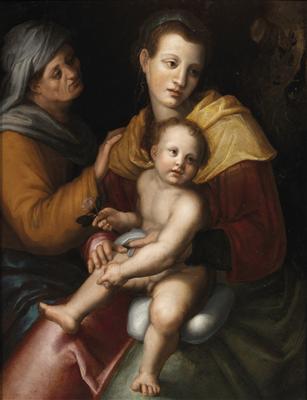Circle of Jacopo Carucci, called Pontormo (Pontormo near Empoli 1494 – 1556 Florence)
Circle of Jacopo Carucci, called Pontormo (Pontormo near Empoli 1494 – 1556 Florence)

The Madonna and Child with Saint Anne, oil on panel, 77 x 61 cm, framed
Provenance:
Line Collection, London;
Sale, Christie´s, London, 11 March 1918, lot 107 (as del Sarto);
Vicomte du Poulpiquet del Halgouet, Château de Tregranteur, Guegon, Morbihan, Brittany;
private collection, Brussels.
The present composition, with its long forms and uses of chiaroscuro, is strongly reminiscent of Pontormo, the leading painter in mid-16th Century Florence and one of the most original and extraordinary of Mannerist artists. The Christ Child in the present work in particular is extremely close to the facial type employed by the artist and can be compared to the Madonna and Child with the Infant Saint John the Baptist formerly in the Borghi Collection, New York (see P. Costamagna Pontormo, Milan 1994, pp. 266/67, no. 86).
Pontormo’s major follower was Bronzino, his pupil in the 1520s, who transformed his master’s early Mannerism into the mid-Century maniera. Also influenced by Pontormo was Giovan Battista Naldini, Pontormo’s pupil between 1549 and 1556. After Pontormo’s death in the later 16th Century, some Florentine artists, including Maso da San Friano, Girolamo Machietti and Mirabello Cavalori (1510/20–72), participated in a revival of Pontormo’s style, and elements from Pontormo can also be discerned in the two elegant and brilliantly coloured pictures Cavalori painted for the studiolo of Francesco I in the Palazzo Vecchio: The Sacrifice of Lavinia and The Wool Factory (c. 1570–72; both in situ). Unlike most of his Mannerist contemporaries, Cavalori emulated the master he admired not so much by imitation of specific motifs, but by truly understanding and simulating his ways of seeing and describing, and by carrying the most advanced researches in the handling of light and space to the next logical stage. The comparative naturalism of these elements in the Wool Factory influenced both Macchietti and Santi di Tito and thereby played a consequential role in the formation of a Baroque style in Florence (see From Studio to Studiolo: Florentine Draftsmanship under the First Medici Grand Dukes, exhibition catalogue, L. Feinberg, Oberlin College, Ohio, Allen Memorial Art Museum, 1991; and L. Feinberg, Oxford Art Dictionary). The chromatic references in the present painting can be compared to Cavalori’s Raising of Lazarus (sale, Piasa, Paris 26 March 2010, lot 52).
17.10.2012 - 18:00
- Odhadní cena:
-
EUR 200.000,- do EUR 300.000,-
Circle of Jacopo Carucci, called Pontormo (Pontormo near Empoli 1494 – 1556 Florence)
The Madonna and Child with Saint Anne, oil on panel, 77 x 61 cm, framed
Provenance:
Line Collection, London;
Sale, Christie´s, London, 11 March 1918, lot 107 (as del Sarto);
Vicomte du Poulpiquet del Halgouet, Château de Tregranteur, Guegon, Morbihan, Brittany;
private collection, Brussels.
The present composition, with its long forms and uses of chiaroscuro, is strongly reminiscent of Pontormo, the leading painter in mid-16th Century Florence and one of the most original and extraordinary of Mannerist artists. The Christ Child in the present work in particular is extremely close to the facial type employed by the artist and can be compared to the Madonna and Child with the Infant Saint John the Baptist formerly in the Borghi Collection, New York (see P. Costamagna Pontormo, Milan 1994, pp. 266/67, no. 86).
Pontormo’s major follower was Bronzino, his pupil in the 1520s, who transformed his master’s early Mannerism into the mid-Century maniera. Also influenced by Pontormo was Giovan Battista Naldini, Pontormo’s pupil between 1549 and 1556. After Pontormo’s death in the later 16th Century, some Florentine artists, including Maso da San Friano, Girolamo Machietti and Mirabello Cavalori (1510/20–72), participated in a revival of Pontormo’s style, and elements from Pontormo can also be discerned in the two elegant and brilliantly coloured pictures Cavalori painted for the studiolo of Francesco I in the Palazzo Vecchio: The Sacrifice of Lavinia and The Wool Factory (c. 1570–72; both in situ). Unlike most of his Mannerist contemporaries, Cavalori emulated the master he admired not so much by imitation of specific motifs, but by truly understanding and simulating his ways of seeing and describing, and by carrying the most advanced researches in the handling of light and space to the next logical stage. The comparative naturalism of these elements in the Wool Factory influenced both Macchietti and Santi di Tito and thereby played a consequential role in the formation of a Baroque style in Florence (see From Studio to Studiolo: Florentine Draftsmanship under the First Medici Grand Dukes, exhibition catalogue, L. Feinberg, Oberlin College, Ohio, Allen Memorial Art Museum, 1991; and L. Feinberg, Oxford Art Dictionary). The chromatic references in the present painting can be compared to Cavalori’s Raising of Lazarus (sale, Piasa, Paris 26 March 2010, lot 52).
|
Horká linka kupujících
Po-Pá: 10.00 - 17.00
old.masters@dorotheum.at +43 1 515 60 403 |
| Aukce: | Obrazy starých mistr? |
| Typ aukce: | Salónní aukce |
| Datum: | 17.10.2012 - 18:00 |
| Místo konání aukce: | Wien | Palais Dorotheum |
| Prohlídka: | 06.10. - 17.10.2012 |
